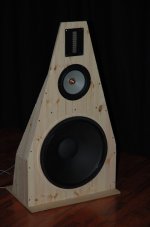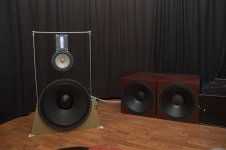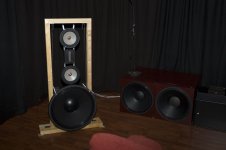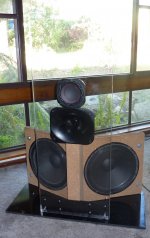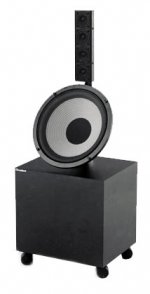Speaker on a Swing
Stig Erik Tangen,
the designer of the "Almighty Subwoofers" and other impressive projects has undertaken a great trip into swingin' speakers
Read the full story here:
http://www.diyaudio.com/forums/multi-way/142015-my-open-baffle-dipole-beyma-tpl-150-a.html
 Michael
Michael
Stig Erik Tangen,
the designer of the "Almighty Subwoofers" and other impressive projects has undertaken a great trip into swingin' speakers
Read the full story here:
http://www.diyaudio.com/forums/multi-way/142015-my-open-baffle-dipole-beyma-tpl-150-a.html
Attachments
Very tidy implementation of LinkwitzLab Phoenix:
http://www.403forbidden.net/Audio/SoCalDIY2003.html

They seem to use Seas drivers instead of the original ScanSpeak.
Also a closeup of another dipole system from the background:

http://www.403forbidden.net/Audio/SoCalDIY2003.html
They seem to use Seas drivers instead of the original ScanSpeak.
Also a closeup of another dipole system from the background:
DNA Sequence:
DNA Sequence Speakers dipole open baffle woofer high efficiency point source array midrange tweeter treble loudspeaker
For the tube "die-hard", a 10 tube (4 6SN7s and 6 6C45s), single-ended class A, zero-feedback, all triode active crossover is employed. Satellite highpass section is ultra quiet with very wide bandwidth. Uses over 400 parts including Audio Note copper foil capacitors. Note the double decker power supply! Black acrylic faceplate is custom laser engraved. Designed by legendary circuit genius Brad Wood. Includes bass level control for gain matching of different amplifiers.
DNA Sequence Speakers dipole open baffle woofer high efficiency point source array midrange tweeter treble loudspeaker
An externally hosted image should be here but it was not working when we last tested it.
An externally hosted image should be here but it was not working when we last tested it.
An externally hosted image should be here but it was not working when we last tested it.
For the tube "die-hard", a 10 tube (4 6SN7s and 6 6C45s), single-ended class A, zero-feedback, all triode active crossover is employed. Satellite highpass section is ultra quiet with very wide bandwidth. Uses over 400 parts including Audio Note copper foil capacitors. Note the double decker power supply! Black acrylic faceplate is custom laser engraved. Designed by legendary circuit genius Brad Wood. Includes bass level control for gain matching of different amplifiers.
DNA Sequence:
DNA Sequence Speakers dipole open baffle woofer high efficiency point source array midrange tweeter treble loudspeaker
An externally hosted image should be here but it was not working when we last tested it.An externally hosted image should be here but it was not working when we last tested it.An externally hosted image should be here but it was not working when we last tested it.
For the tube "die-hard", a 10 tube (4 6SN7s and 6 6C45s), single-ended class A, zero-feedback, all triode active crossover is employed. Satellite highpass section is ultra quiet with very wide bandwidth. Uses over 400 parts including Audio Note copper foil capacitors. Note the double decker power supply! Black acrylic faceplate is custom laser engraved. Designed by legendary circuit genius Brad Wood. Includes bass level control for gain matching of different amplifiers.
that looks really impressive!!
I used 3 parts in my crossover.
bit is not active of course.
nice work!
Hello SunRa,
Yes, 18sound 6ND430s, with XT1086 waveguides and NSD1095N compression drivers.
Mid/tweeter baffle is 25mm acrylic (1200mm X 450mm), which is wedged to the steel, cork covered, woofer baffle.
Eminence EMI 1550 woofers. With a pair of sealed subwoofers.
The sound is clearly the best I've produced yet!
the best I've produced yet!
The 6ND430 has proven to be excellent for OB. Neodymium magnet leaves the basket quite open. +/- 5mm linear Xmax, which is not called upon with the 170Hz, 24 dB/octave Xover. MUCH more detailed than the PHY-HPs, and in fact all the other mids I have tried.
The whole system has proven to be very dynamic, with no sense of compression. As I've learnt how to tune in the DEQX (getting the cleanest impulse response), it has become very detailed indeed.
Regards,
David
Yes, 18sound 6ND430s, with XT1086 waveguides and NSD1095N compression drivers.
Mid/tweeter baffle is 25mm acrylic (1200mm X 450mm), which is wedged to the steel, cork covered, woofer baffle.
Eminence EMI 1550 woofers. With a pair of sealed subwoofers.
The sound is clearly
 the best I've produced yet!
the best I've produced yet!The 6ND430 has proven to be excellent for OB. Neodymium magnet leaves the basket quite open. +/- 5mm linear Xmax, which is not called upon with the 170Hz, 24 dB/octave Xover. MUCH more detailed than the PHY-HPs, and in fact all the other mids I have tried.
The whole system has proven to be very dynamic, with no sense of compression. As I've learnt how to tune in the DEQX (getting the cleanest impulse response), it has become very detailed indeed.
Regards,
David
Almost bought a pair in need of a refurbishing. Opted out since I couldnt find any info on the drivers etc (at least not in the time I had to make the decision)
The Gradient 1.3 Revisited
amt
The Gradient 1.3 Revisited
amt
Attachments
Hello David,
Thank you very much for your reply! Much appreciated! What is the crossover point between the waveguide and the 6nd430? Around 1400 Hz?
Also, to which midranges are you comparing the 6nd430 besides the PHY-HP? Maybe I had the chance to listen one of those
Many thanks!
Thank you very much for your reply! Much appreciated! What is the crossover point between the waveguide and the 6nd430? Around 1400 Hz?
Also, to which midranges are you comparing the 6nd430 besides the PHY-HP? Maybe I had the chance to listen one of those
Many thanks!
Hello SunRa,
Mid/tweeter at 1600 Hz, FIR equivalent to 260 dB per octave!! (DEQX gives an option down to 48 dB per octave, linear phase, which is the region I inhabited until recently. After much comparison, the higher slope proved to sound better).
Fostex FE206E, Jordan Xjr 6HD, Audio Nirvana 8" amongst the wide rangers, Focal 7N303 and 7" and 5" double voice coil models, Seas M15CH001, as well as the PHY-HP.
Obviously not a comprehensive list, but I've heard the Scanspeak Revelator and the Seas metal drivers, and haven't been satisfied.
David
Mid/tweeter at 1600 Hz, FIR equivalent to 260 dB per octave!! (DEQX gives an option down to 48 dB per octave, linear phase, which is the region I inhabited until recently. After much comparison, the higher slope proved to sound better).
Fostex FE206E, Jordan Xjr 6HD, Audio Nirvana 8" amongst the wide rangers, Focal 7N303 and 7" and 5" double voice coil models, Seas M15CH001, as well as the PHY-HP.
Obviously not a comprehensive list, but I've heard the Scanspeak Revelator and the Seas metal drivers, and haven't been satisfied.
David
Hi tnargs,
Obviously with DEQX I'm constrained to FIR for the mid/tweeter. They use IIR for equalization (if implemented- I don't use it). It is possible to use LR or Butterworth for mid/woofer, and I use LR 24 dB per octave.
The mid is delayed with respect to the tweeter, so at the seating position I receive a coherent waveform. However, if I move to the right or left, or backwards or forwards, I still seem to be equidistant to the virtual sources (the tweeter is delayed too, for the generation of the filter).
I do not calibrate DEQX at the seating position, but rather place the mic about 1 cm from each cone surface. This corrects the group delay for each driver before generating the crossover, and time delay is then added as appropriate. No floor bounce or wall reflection is included in the measurement.
So, not knowing digital filter theory, I am not sure what the deficiencies of FIR are in this instance. Pre-ringing is obviously a negative theoretical contribution, but one reason for selecting the slope that I have is that it is a very compact, well damped impulse response.
I can't compare the sound of FIR versus IIR with this setup, so I would like to know the issues involved, if you wouldn't mind elaborating.
David
Obviously with DEQX I'm constrained to FIR for the mid/tweeter. They use IIR for equalization (if implemented- I don't use it). It is possible to use LR or Butterworth for mid/woofer, and I use LR 24 dB per octave.
The mid is delayed with respect to the tweeter, so at the seating position I receive a coherent waveform. However, if I move to the right or left, or backwards or forwards, I still seem to be equidistant to the virtual sources (the tweeter is delayed too, for the generation of the filter).
I do not calibrate DEQX at the seating position, but rather place the mic about 1 cm from each cone surface. This corrects the group delay for each driver before generating the crossover, and time delay is then added as appropriate. No floor bounce or wall reflection is included in the measurement.
So, not knowing digital filter theory, I am not sure what the deficiencies of FIR are in this instance. Pre-ringing is obviously a negative theoretical contribution, but one reason for selecting the slope that I have is that it is a very compact, well damped impulse response.
I can't compare the sound of FIR versus IIR with this setup, so I would like to know the issues involved, if you wouldn't mind elaborating.
David
I'm no expert, but with FIR filters, the steeper the slope the more the impulse rings. It works by adding a ringing HP signal to a ringing LP signal in ways that cancel out. But it only cancels out for 2 drivers with exactly the same acoustic source and driver size, which never happens in the real world.
In reality the listening room fills with uncancelled ringing. The direct sound rings off axis (and remember one cannot get two ears on axis), so all reflected sound is highly compromised by strong ringing because most reflections are well off axis.
It is at this point of my thinking that I jump to a conclusion and decide it's IIR for me.
PS we have the same tweeter!
In reality the listening room fills with uncancelled ringing. The direct sound rings off axis (and remember one cannot get two ears on axis), so all reflected sound is highly compromised by strong ringing because most reflections are well off axis.
It is at this point of my thinking that I jump to a conclusion and decide it's IIR for me.
PS we have the same tweeter!
Here's my entry:
Maybe not worthy of ultimate, but they sound like it!
Dan
An externally hosted image should be here but it was not working when we last tested it.
An externally hosted image should be here but it was not working when we last tested it.
An externally hosted image should be here but it was not working when we last tested it.
An externally hosted image should be here but it was not working when we last tested it.
An externally hosted image should be here but it was not working when we last tested it.
An externally hosted image should be here but it was not working when we last tested it.
Maybe not worthy of ultimate, but they sound like it!
Dan
Hi tnargs,
I can see that whatever ringing there is will occur off-axis when the freq response, polar response, deviates from the on-axis response. This certainly doesn't seem to happen within the few degrees that the arc of two ears subtends.
Given the CD nature of the waveguide, the freq response holds up well for quite an angle.
The impulse response doesn't correlate with steepness of slope, even though perhaps it should theoretically. First of all, the mid rings less with FIR than without, according to the measured impulse response (and the order of the high pass).
Secondly, it seems that it is the tweeter that shows a change in ringing, but there is not necessarily less at a lower order. It has taken a lot of experimentation to discover that the best slope depends on the driver(s). i.e. on what correction is needed to achieve flat freq response and group delay.
Given the precedence effect, I'm not sure what the significance of reflected ringing sound would be, especially when mixed with reflections that are incoherent anyway.
What does FIR ringing sound like? I'm aware that a well tuned DEQX sounds clear, detailed, and non-fatiguing. (a DEQX tuned by a novice sounds muddied and non-fatiguing).
What horn/waveguide are you using, and how did you arrive at the choice of horn and driver?
David
I can see that whatever ringing there is will occur off-axis when the freq response, polar response, deviates from the on-axis response. This certainly doesn't seem to happen within the few degrees that the arc of two ears subtends.
Given the CD nature of the waveguide, the freq response holds up well for quite an angle.
The impulse response doesn't correlate with steepness of slope, even though perhaps it should theoretically. First of all, the mid rings less with FIR than without, according to the measured impulse response (and the order of the high pass).
Secondly, it seems that it is the tweeter that shows a change in ringing, but there is not necessarily less at a lower order. It has taken a lot of experimentation to discover that the best slope depends on the driver(s). i.e. on what correction is needed to achieve flat freq response and group delay.
Given the precedence effect, I'm not sure what the significance of reflected ringing sound would be, especially when mixed with reflections that are incoherent anyway.
What does FIR ringing sound like? I'm aware that a well tuned DEQX sounds clear, detailed, and non-fatiguing. (a DEQX tuned by a novice sounds muddied and non-fatiguing).
What horn/waveguide are you using, and how did you arrive at the choice of horn and driver?
David
Hi, dantheman,
It's an interesting mounting method on your Silver Iris and baffle. It looks like a rear mounting at the first sight of the rear structure, but the frame can also be seen at the front. So, it's a big 'through-hole' on the baffle? How do you deal with that circulat gap between baffle hole and driver's frame?
Best Regards,
CLS
It's an interesting mounting method on your Silver Iris and baffle. It looks like a rear mounting at the first sight of the rear structure, but the frame can also be seen at the front. So, it's a big 'through-hole' on the baffle? How do you deal with that circulat gap between baffle hole and driver's frame?
Best Regards,
CLS
Thanks guys!
CLS, I can't say I hear or measure a need to deal with the slight gap. Though a do plan on devising a mount for the Augie to attach to the baffle as well, or maybe just weather stripping it. The only thing that stops me from doing that now is the possibility of going IB with it. The gap is actually far less visible with better placement of the woofer. I just moved it to get it more in the photo and didn't line it up very well. Laziness.
Gainphile:
The finish on the baffle is fairly straight forward, Just some stain I had laying around (I think the color was called Deep Mahogany?) and a bit of a satin finish. I think four layers of each and sanded progressively finer with each layer. It looks WAY better in person! The wood is 3/4" BB with another 1/8" over the middle to flush mount the FRer. All the round overs are done with a mallet and chisel, straight file, and then sandpaper grits from 60-400. On the rear of the baffle the FRer cutout is also smoothed and rounded over. There's something about the imperfection of hand work that makes the finish look so rustic--or classy. I wish you could see them in person. MUCH better. The lighter areas are darker and the dark areas are lighter actually. I purposely made them less than perfect--it just suites my mood. Next I'm going to paint those screws black, though they don't bother me much as is.
My goal with this speaker was to create as little resonance as possible. I'm pretty sure I did a decent job of it. If I had it to do over again I probably would have tried to make the round over on the back of the baffle for the FR cutout even wider--more gradual slope. I believe I can hear a treble resonance when I flip the speaker around. Maybe nothing can be done to fix it completely. Anyway, I don't notice it at all from the front.
Thanks for the interest! I posted these in the FR forum and got no responses after 80+ views. I was sort of surprised. I thought they looked decent. Over a hundred views on audiocircle, again no replies? I was beginning to think these were just an uninteresting build. There is actually very good rational for them and preliminary FR looks great. Better than anything else I've measured. As for the sound subjectively--I'm actually overjoyed at the moment. At first I tried to box the little RS100-8s, but just couldn't get used to the box. Now they are awesome! Detail, image, clean, neutral, dynamic, etc... all the audiophile buzzword stuff for under $200. Me gusta mucho.
Thanks again,
Dan
CLS, I can't say I hear or measure a need to deal with the slight gap. Though a do plan on devising a mount for the Augie to attach to the baffle as well, or maybe just weather stripping it. The only thing that stops me from doing that now is the possibility of going IB with it. The gap is actually far less visible with better placement of the woofer. I just moved it to get it more in the photo and didn't line it up very well. Laziness.
Gainphile:
The finish on the baffle is fairly straight forward, Just some stain I had laying around (I think the color was called Deep Mahogany?) and a bit of a satin finish. I think four layers of each and sanded progressively finer with each layer. It looks WAY better in person! The wood is 3/4" BB with another 1/8" over the middle to flush mount the FRer. All the round overs are done with a mallet and chisel, straight file, and then sandpaper grits from 60-400. On the rear of the baffle the FRer cutout is also smoothed and rounded over. There's something about the imperfection of hand work that makes the finish look so rustic--or classy. I wish you could see them in person. MUCH better. The lighter areas are darker and the dark areas are lighter actually. I purposely made them less than perfect--it just suites my mood. Next I'm going to paint those screws black, though they don't bother me much as is.
My goal with this speaker was to create as little resonance as possible. I'm pretty sure I did a decent job of it. If I had it to do over again I probably would have tried to make the round over on the back of the baffle for the FR cutout even wider--more gradual slope. I believe I can hear a treble resonance when I flip the speaker around. Maybe nothing can be done to fix it completely. Anyway, I don't notice it at all from the front.
Thanks for the interest! I posted these in the FR forum and got no responses after 80+ views. I was sort of surprised. I thought they looked decent. Over a hundred views on audiocircle, again no replies? I was beginning to think these were just an uninteresting build. There is actually very good rational for them and preliminary FR looks great. Better than anything else I've measured. As for the sound subjectively--I'm actually overjoyed at the moment. At first I tried to box the little RS100-8s, but just couldn't get used to the box. Now they are awesome! Detail, image, clean, neutral, dynamic, etc... all the audiophile buzzword stuff for under $200. Me gusta mucho.
Thanks again,
Dan
Hi tnargs, <snip> What horn/waveguide are you using, and how did you arrive at the choice of horn and driver?
Same tweeter as you David, NSD1095N/XT1086. Bit of a long story how I arrived at it, partly based on my beamwidth and response needs, partly on the great technology in the design, and partly because I have seen some extensive modeling, analysis and measurements of a cheaper compression driver from the same company, which came out with a very high pass mark... the seem to get all the details right, unlike, for example, Beyma.
- Home
- Loudspeakers
- Multi-Way
- Ultimate Open Baffle Gallery
